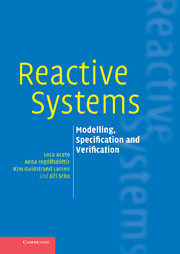Book contents
- Frontmatter
- Contents
- Figures and tables
- Preface
- I A Classic Theory of Reactive Systems
- 1 Introduction
- 2 The language CCS
- 3 Behavioural equivalences
- 4 Theory of fixed points and bisimulation equivalence
- 5 Hennessy–Milner logic
- 6 HML with recursion
- 7 Modelling mutual exclusion algorithms
- II A Theory of Real-time Systems
- Appendix A Suggestions for student projects
- References
- Index
1 - Introduction
from I - A Classic Theory of Reactive Systems
Published online by Cambridge University Press: 17 March 2011
- Frontmatter
- Contents
- Figures and tables
- Preface
- I A Classic Theory of Reactive Systems
- 1 Introduction
- 2 The language CCS
- 3 Behavioural equivalences
- 4 Theory of fixed points and bisimulation equivalence
- 5 Hennessy–Milner logic
- 6 HML with recursion
- 7 Modelling mutual exclusion algorithms
- II A Theory of Real-time Systems
- Appendix A Suggestions for student projects
- References
- Index
Summary
Aims of this book
The aim of the first part of this book is to introduce three basic notions that we shall use to describe, specify and analyse reactive systems, namely
Milner's calculus of communicating systems (CCS) (Milner, 1989),
the model known as labelled transition systems (LTSs) (Keller, 1976), and
Hennessy–Milner logic (HML) (Hennessy and Milner, 1985) and its extension with recursive definitions of formulae (Larsen, 1990).
We shall present a general theory of reactive systems and its applications. In particular, we intend to show the following:
how to describe actual systems using terms in our chosen models (i.e. either as terms in the process description language CCS or as labelled transition systems);
how to offer specifications of the desired behaviour of systems either as terms of our models or as formulae in HML; and
how to manipulate these descriptions, possibly (semi-)automatically, in order to analyse the behaviour of the model of the system under consideration.
In the second part of the book, we shall introduce a similar trinity of basic notions that will allow us to describe, specify and analyse real-time systems – that is, systems whose behaviour depends crucially on timing constraints. There we shall present the formalisms of timed automata (Alur and Dill, 1994) and timed CCS (Yi, 1990, 1991a, b) to describe real-time systems, the model of timed labelled transition systems (TLTSs) and a real-time version of Hennessy–Milner logic (Laroussinie, Larsen and Weise, 1995).
- Type
- Chapter
- Information
- Reactive SystemsModelling, Specification and Verification, pp. 1 - 6Publisher: Cambridge University PressPrint publication year: 2007

